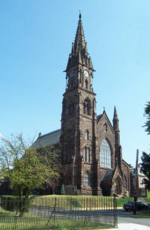Orange High School (New Jersey)
1869 establishments in New JerseyEducational institutions established in 1869Middle States Commission on Secondary SchoolsOrange, New JerseyPublic high schools in Essex County, New Jersey ... and 2 more
Use American English from August 2020Use mdy dates from March 2021
Orange High School is a three-year comprehensive public high school that serves students in tenth through twelfth grades from Orange in Essex County, in the U.S. state of New Jersey, operating as part of the Orange Board of Education. The school has been accredited by the Middle States Association of Colleges and Schools Commission on Elementary and Secondary Schools since 1928.As of the 2021–22 school year, the school had an enrollment of 973 students and 86.3 classroom teachers (on an FTE basis), for a student–teacher ratio of 11.3:1. There were 532 students (54.7% of enrollment) eligible for free lunch and 37 (3.8% of students) eligible for reduced-cost lunch.
Excerpt from the Wikipedia article Orange High School (New Jersey) (License: CC BY-SA 3.0, Authors).Orange High School (New Jersey)
Lincoln Avenue,
Geographical coordinates (GPS) Address Phone number Website External links Nearby Places Show on map
Geographical coordinates (GPS)
| Latitude | Longitude |
|---|---|
| N 40.765555555556 ° | E -74.239166666667 ° |
Address
Orange High School
Lincoln Avenue 400
07050
New Jersey, United States
Open on Google Maps









